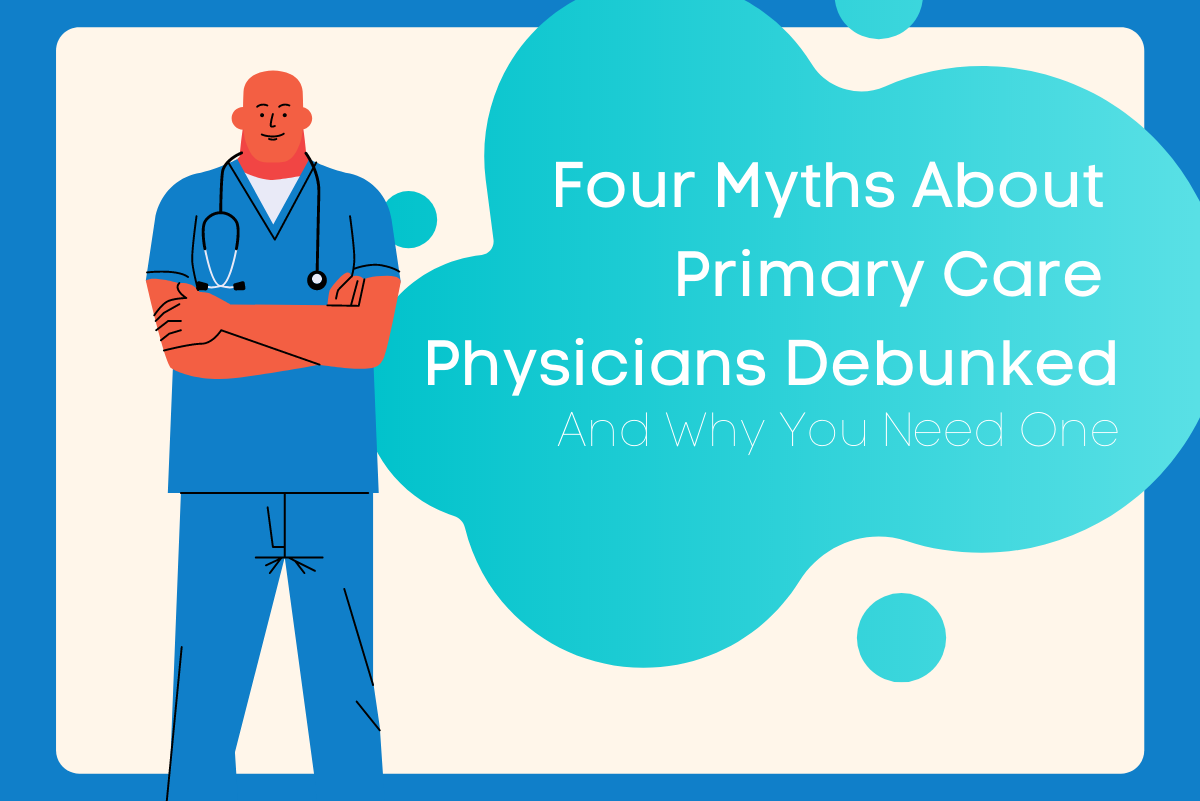Four Myths About Primary Care Physicians Debunked: And Why You Need One
March 8, 2021
By: Emerson Woodham
Categories: Blog Posts, Healthy Living
What do primary care physicians do and what's the difference between internal and family medicine?
What exactly is Primary Care?
In short, it’s routine care, such as diagnosing and treating a cough with fever, or managing your blood pressure medication, or performing your annual check-up. Taking a closer look, the overall questions that arise are what do primary care physicians do and what's the difference between internal medicine and family medicine? Here are the answers.
You may have heard of “primary care doctor” or “primary care physician,” but maybe you’ve never gotten a clear definition or understood what the role of this type of doctor is. If you need a place to go when you are feeling under the weather or sustain an injury, or want a regular wellness check to make sure your health is on track, primary care can provide you with those services.
A primary care physician is a provider who practices general medicine and is trained to prevent, diagnose, and treat an array of illnesses and injuries. Primary care physicians provide comprehensive care, meaning they can address chronic, long-term conditions like diabetes as well as acute problems like colds. They are often the first contact you or your family members have within the healthcare system.
What does a Primary Care Physician do?
A primary care physician (PCP) addresses a wide range of health concerns for patients. They are typically the first professional you work with if you have a health concern. You might go to them for:
- Treatment of common illnesses
- Preventive care and wellness visits
- Management of chronic conditions
- Early identification of illnesses or conditions
- Management of medications and writing prescriptions
- Referrals for testing or to see specialists
Most patients build bonds with their primary care doctors that may last for years or even decades. It is not uncommon for an entire family to use the same doctor.
What kind of Primary Care Physician do you need?
There are five main types of physicians who provide primary care. Here’s a quick breakdown of the five types of primary care doctors, and why you might consider each type for your own care.
- Family doctors - These physicians treat patients of all ages and genders and are trained in a variety of medical subjects. The unique benefit of family medicine doctors is that they care for your whole family, often starting with infants.
- Internists – These physicians practice internal medicine. They are generally more geared towards the medical care of adults. Internal medicine physicians focus on general wellness and many common conditions such as diabetes, high blood pressure, and obesity.
- Pediatricians – These physicians focus on development, wellness, vaccination, and treatment of the conditions that can affect babies, children, and teenagers up to the age of 21. When caring for younger children, pediatricians advise parents on the growth and development of their children.
- Geriatricians – These physicians specialize in treating adults over the age of 60. They diagnose and treat diseases and injuries common among older adults and bring specialized expertise to needs such as assistance in the home and dementia.
- Obstetrician-gynecologists (OB-GYN) – These doctors specialize in women’s health and expertise in pregnancy, reproductive health, childbirth, and postpartum conditions.
A primary care physician can help you reach or maintain your best health potential!
Myths about Primary Care Physicians
Myth #1: A primary care physician is someone you see only when you are sick.
False: It is true that primary care physicians are trained to diagnose and treat a range of acute and chronic illnesses. However, visiting your primary care physician is important not just when you are in poor health, but also when you are in good health, too. Scheduling an annual wellness exam is vital to help prevent illness or to catch developing conditions early, treatment is most likely to be successful.
Myth #2: Any health professional can perform primary care.
False: First, in order to become a primary care doctor, they have to complete medical school. Then they must complete 3 years of internal medicine or family practice residency, which is a supervised, hands-on program usually served in a hospital setting. Finally, they have to pass a rigorous examination and be licensed by their state to practice medicine. Primary care physicians must know a lot about anatomy, disease processes, and medications in order to treat the array of cases that come through their office. Primary care physicians often are assisted by certified nurse practitioners or physician's assistants, who provide care under the supervision of the PCP.
Myth #3: A primary care physician's referral is usually needed before seeing a specialist.
Usually True: Most insurance plans require you to get a referral from your PCP before you can see a specialist such as a surgeon or a neurologist. The exception is OB-GYNs (they are considered primary care physicians under most insurance plans) or if you are having a medical emergency and go to a hospital Emergency Department.
Myth #4: I don’t need a PCP.
False: Most people do need a PCP. Your physician knows you and your medical history. He or she is in a better position to partner with you than an urgent care provider you may never have seen before. Also, going to your PCP with relatively minor complaints can save you hours of waiting (and potentially higher costs) in an Emergency Department. And, finally, your PCP can advise you on ways to prevent illness and avoid conditions that can have a big impact on your quality of life, from cancer to heart disease and stroke.
Are you looking for a Primary Care Physician?
Choose from nine different practices in Clarke, Oconee, Greene, and Franklin counties.
- Athens Internal Medicine Associates, 1500 Oglethorpe Ave, Ste 400A Athens, GA 30606
- Community Internal Medicine of Athens, 1500 Oglethorpe Ave, Bldg. 200C Athens, GA 30606
- Georgia Family Medicine, 2410 Hog Mountain Rd, Bldg. 200, Ste 201 Watkinsville, GA 30677
- Hometown Pediatrics, 1020 Jamestown Blvd, Bldg. 200, Watkinsville, Georgia 30677
- St. Mary's Primary Care, 1500 Oglethorpe Ave, Ste 200A Athens, GA 30606
- Sacred Heart Primary Care, 355 Clear Creek Pkwy, Ste 1003 Lavonia, GA 30553
- Good Samaritan Primary Care, 1110 Commerce Dr., Ste 108 Greensboro, GA 30642
- St. Mary’s Family Medicine, 1181 Langford Dr, Bldg 300, Ste 103 Watkinsville, GA 30677
- St. Mary’s Internal Medicine Associates, 2470 Daniells Bridge Road, Bldg. 200, Ste 271 Athens, GA 30606



